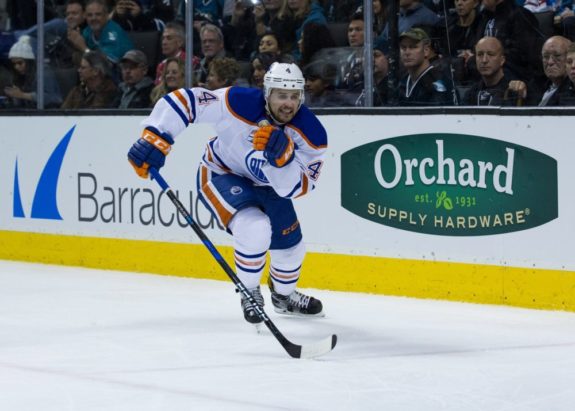For some, he’s a cap killer. For others, he’s a Corsi curse.
But for the Edmonton Oilers, Kris Russell has been much more this season.
A perennial shot-blocking leader in the National Hockey League (NHL), Russell is once again near the top of the leader board when it comes to stopping pucks from reaching the net. The product of Caroline, Alberta is also earning his paycheque in a top-four role for the Oilers.
His detractors will point to a $4 million cap hit for this year and two more seasons after the 2018-19 campaign. It is a lot to pay to someone who appears headed for a spot on the bottom pairing sooner rather than later.
The advanced stats believers will also look at Russell’s Corsi metrics, which consistently point to a player who spends more time in the defensive zone than on the attack, and see a defenseman who does little to help his team pick up wins.
Russell Is a Useful Defenseman on the Oilers
Russell’s critics aren’t necessarily wrong about the left-shooting blueliner’s faults. They may fail, however, to give him credit for what he contributes to the backend of the Oilers.
On a team that is lacking elite defenders – or, at times, even capable defensemen – the 2005 third-round pick of the Columbus Blue Jackets plays a key role on the Oilers. With Andrej Sekera out indefinitely, suffering from a torn Achilles tendon, Edmonton’s defense is short on top-four talent.

Through Edmonton’s first 11 games of the year, Russell has found a home on the Oilers’ second pairing alongside Darnell Nurse. He’s playing over 20 minutes a game and he’s notched four points, all assists. Russell is also a plus-four on the year. Of course, he also leads the team in blocked shots, with 35. The former Medicine Hat Tigers standout currently has the fourth-highest block total in the NHL. Nurse, meanwhile, has one goal, four helpers and is a minus-one playing with Russell.
Related: Oilers’ Klefbom Playing Like a Top Defender
Overall, the Oilers are allowing 3.09 goals per game, which is 15th in the league. Those results are middling, but when you consider that Edmonton’s schedule to start the year included plenty of travel and numerous top-end opponents, it’s not so bad. Emerging with a 6-4-1 record makes the defensive performance palatable.
The problem for the Oilers is that Russell is likely better suited as a fifth defenseman, but there is no one currently capable of filling in on the second pairing.
Who Else Can Play in the Top Four?
Head coach Todd McLellan has rotated four players through the bottom pairing, including rookie Evan Bouchard, Kevin Gravel, Matt Benning and Jason Garrison. All of them are averaging under 13 minutes of ice time per game and they have all registered negative plus/minus totals. Bouchard, who has the most offensive upside and is a solid candidate for power play time, has the worst plus/minus among defenders at minus-five.
Related: 3 Fears for Oilers Fans this Halloween
If Bouchard stays with the Oilers (he could soon be demoted to the London Knights of the Ontario Hockey League), it is possible that he settles in to a top-four position. If not, perhaps Ethan Bear or Caleb Jones could be summoned from the Bakersfield Condors of the American Hockey League (AHL) and plugged into a second-pairing slot. That seems unlikely at this point.
For now, the team should appreciate what Russell has done for the Oilers. Longer term, general manager Peter Chiarelli should be looking at bringing in another defenseman because Sekera won’t be back soon and another injury on the back end could prove devastating. Even if the defense remains healthy, the top four blueliners will need a break on occasion. McLellan can only reduce their ice time if the bottom pairing is capable of keeping the puck out of the Oilers’ net.